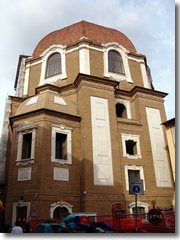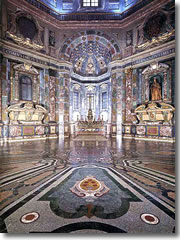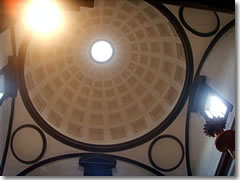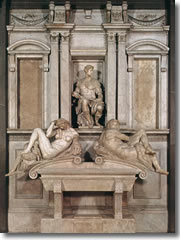
The Medici Chapels in Florence. Imagine if you had all the money in the world, none of the renowned artistic taste of your famous ancestors, and a firm belief that, the bigger you made your tomb and the more you festooned it with precious marbles and decorative frippery, the greater your chances of getting into Heaven (or at least being remembered here on Earth).
That's the Medici Chapels.
And then there is also the relatively bare basement room with amazing tomb statues by Michelangelo—possibly the best compare/contrast object lesson in how less can be more... and more is sometimes much, much less.
Technically, this complex comprises both the Cappella dei Principi and the Sagrestia Nuova (New Sacristy) of San Lorenzo church, but you can no longer get into it from the church itself. You have to thread your way through the stalls of the surrounding leather market to get around to the back side of the church and the separate entrance.
 The Medici have been buried here since the 15th century, but the current "Chapel of the Princes" was started in the late 17th century and not finished until 1869.
The Medici have been buried here since the 15th century, but the current "Chapel of the Princes" was started in the late 17th century and not finished until 1869.
Its main vault is inlaid with a decorative mosaic of polychrome marbles and pietre dure (inlay of semiprecious stones) serving as a gaudy backdrop for the grandiose tombs of the later Medici Grand Dukes, and therefore commonly referred to as the Cappella dei Principi, or Chapel of the Princes (even though, technically, the Medici were never princes of anything, merely Grand Dukes).
Odds are, the more ostentatious the tomb, the lesser the Medici. Honestly, save for a few standouts, after Cosimo I—the first to become Duke, then later Grand Duke—it was pretty much downhill for quality in the Medici lineage.
The greatest members of the clan—Cosimo Il Vecchio and his grandson Lorenzo The Magnificent—came several generations earlier (before the family even had official titles and were merely the most respected bankers in town), and aren't even entombed here. The Cosimo generation is back in the Old Sacristy of San Lorenzo itself; Lorenzo is in the New Sacristy (below).
Feel free to hustle through this phantasmagoria of conspicuous wealth, because the best part of the tombs are downstairs.
That's where the keep the Michelangelos.

The New Sacristy, designed by Michelangelo.A corridor leads down to the Sagrestia Nuova (New Sacristy), a cramped inner chamber that is the real draw of the Medici Chapels, a smorgasbord of Michelangelo: sculpture, architecture, and drawings.
Sangallo probably started the chapel, but Michelangelo took over in 1520 to turn it into a final resting place for the Medici, the architecture drawn along cold, hard lines of dark gray pietra serena stone and white plaster and using tricks of perspective in the upper reaches to make the chapel seem airier.
There are basically three groupings of Michelangelo statues here.
To the left is the tomb of Lorenzo II, Duke or Urbino (grandson to Lorenzo the Magnificent), looking pensive under his helmet, with his finger to his lips.
To the right is the tomb of Giuliano, Duke of Nemours (third son of Lorenzo the Magnificent), with a serpentine neck and a nude-style breastplate modeled on ancient Roman statues.

Michelangelo's tomb of Giuliano, Duke of Nemours, with Day and Night Much more famous (and compelling) than the figures of these undistinguished Medici are the allegorical figures just below them, reclining along the slow curves of the tomb architecture: Day (the male) and Night (female) beneath Giuliano, twisting their nude bodies across from Dawn and Dusk under Lorenzo.
If nothing else, these four sculptures strengthen the widely-held theory that Michelangelo was gay. The two male figures are sturdy, muscular, and crafted with a meticulous eye for detail, but the man who carved Night and Dusk clearly never bothered getting a proper look at a woman. The two "female" figures are basically men with their muscles shaved down and smoothed a bit, hips widened, and a couple of breasts tacked on at anatomically suspect angles.
Against the entrance wall there was supposed to be the most grandiose tomb of all, for Lorenzo "The Magnificent" de' Medici and his brother Giuliano, who was slain in the Cathedral during the Pazzi Conspiracy.
Sadly, Michelangelo never got around to finishing anything more than a sweet Madonna and Child statue, and Lorenzo—perhaps the most famous patron of the arts in all the Renaissance—rests under a simple stone slab.
The chapel holds one last surprise Michelangelo. Duck under the low door to the left of the altar into a tiny chamber holding reliquaries of saints—and a few wall doodles under Plexiglas. Discovered in 1975 these charcoal drawings were apparently sketched by Michelangelo around 1530, when he was hiding out here under the protection of San Lorenzo's prior.
Why did the greatest artist of his age—perhaps of all time—need to hide? Well, Michelangelo had eventually thrown his lot in with the Republican crowd after they ousted (temporarily, as it would turn out) the Medici from power and drove the family from the city.
After the Medici returned, they rashly placed their erstwhile former family artist on the list of traitors to be executed. Within a year, though, Pope Clement VII (born Giulio de' Medici, illegitimate son of the slain Giuliano and hence nephew of Lorenzo the Magnificent) issued an edict to go easy on Michelangelo, and the artist was able to show his face again. Michelangelo promptly left for greener pastures in Rome, never to return to his beloved Florence until his body was returned here after his death.
Share this page
Search ReidsItaly.com
Piazza Madonna degli Aldobrandini 6 (around the back of San Lorenzo church, where Via del Giglio meets Via del Canto de' Nelli)
tel. +39-055-238-8602
www.polomuseale.firenze.it
Tickets: Select Italy
Daily 8:15am–1:50pm (in summer, sometimes open to 4:50pm; see "Tips")
Closed 1st, 3rd, 5th Mon of each month and 2nd, 4th Sunday of each month
€6.00
Tickets: Select Italy
With Firenze Card: Free
Bus: C1
Hop-on/hop-off: Stazione FS SMN (A,B), Piazza Stazione (C)